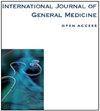Diagnostic Value of Artificial Intelligence in Minimal Breast Lesions Based on Real-Time Dynamic Ultrasound Imaging
IF 2
4区 医学
Q2 MEDICINE, GENERAL & INTERNAL
引用次数: 0
Abstract
Purpose: : To explore the diagnostic value of artificial intelligence (AI)-based on real-time dynamic ultrasound imaging system for minimal breast lesions.Patients and Methods: Minimal breast lesions with a maximum diameter of ≤ 10mm were selected in this prospective study. The ultrasound equipment and AI system were activated Simultaneously. The ultrasound imaging video is connected to the server of AI system to achieve simultaneous output of AI and ultrasound scanning. Dynamic observation of breast lesions was conducted via ultrasound. And these lesions were evaluated and graded according to the Breast Imaging Reporting and Data System (BI-RADS) classification system through deep learning (DL) algorithms in AI. Surgical pathology was taken as the gold standard, and ROC curves were drawn to determine the area under the curve (AUC) and the optimal threshold values of BI-RADS. The diagnostic efficacy was compared with the use of a BI-RADS category > 3 as the threshold for clinically intervening in diagnosing minimal breast cancers.
Results: 291 minimal breast lesions were enrolled in the study, of which 228 were benign (78.35%) and 63 were malignant (21.65%). The AUC of the ROC curve was 0.833, with the best threshold value > 4A. When using >BI-RADS 3 and >BI-RADS 4A as threshold values, the sensitivity and negative predictive value for minimal breast cancers were higher for >BI-RADS 3 than >BI-RADS 4A (100% vs 65.08%, 100% vs 89.91%, P values < 0.001). However, the corresponding specificity, positive predictive value, and accuracy were lower than those for >BI-RADS 4A (42.11% vs 85.96%, 32.31% vs 56.16%, and 54.64% vs 81.44%, P values < 0.001).
Conclusion: The AI-based real-time dynamic ultrasound imaging system shows good capacity in diagnosing minimal breast lesions, which is helpful for early diagnosis and treatment of breast cancer, and improves the prognosis of patients. However, it still results in some missed diagnoses and misdiagnoses of minimal breast cancers.
Keywords: Breast cancer, ultrasound, artificial intelligence, diagnostic
基于实时动态超声波成像的人工智能对乳腺微小病变的诊断价值
目的: :探索基于人工智能(AI)的实时动态超声成像系统对乳腺微小病变的诊断价值:这项前瞻性研究选择了最大直径≤ 10 毫米的乳腺微小病变。同时启动超声设备和人工智能系统。超声成像视频连接至人工智能系统服务器,实现人工智能和超声扫描同步输出。通过超声波对乳腺病变进行动态观察。通过人工智能中的深度学习(DL)算法,根据乳腺成像报告和数据系统(BI-RADS)的分类系统对这些病变进行评估和分级。以手术病理为金标准,绘制 ROC 曲线以确定曲线下面积(AUC)和 BI-RADS 的最佳阈值。结果:研究共纳入 291 例乳腺微小病变,其中良性病变 228 例(78.35%),恶性病变 63 例(21.65%)。ROC曲线的AUC为0.833,最佳阈值为4A。以 BI-RADS 3 和 BI-RADS 4A 作为阈值时,BI-RADS 3 对极小乳腺癌的灵敏度和阴性预测值均高于 BI-RADS 4A(100% vs 65.08%,100% vs 89.91%,P 值为 0.001)。然而,相应的特异性、阳性预测值和准确性却低于 BI-RADS 4A(42.11% vs 85.96%、32.31% vs 56.16%、54.64% vs 81.44%,P 值为 0.001):基于人工智能的实时动态超声成像系统对乳腺微小病变具有良好的诊断能力,有助于乳腺癌的早期诊断和治疗,改善患者的预后。然而,该系统仍会导致一些极小乳腺癌的漏诊和误诊:乳腺癌 超声波 人工智能 诊断
本文章由计算机程序翻译,如有差异,请以英文原文为准。
求助全文
约1分钟内获得全文
求助全文
来源期刊

International Journal of General Medicine
Medicine-General Medicine
自引率
0.00%
发文量
1113
审稿时长
16 weeks
期刊介绍:
The International Journal of General Medicine is an international, peer-reviewed, open access journal that focuses on general and internal medicine, pathogenesis, epidemiology, diagnosis, monitoring and treatment protocols. The journal is characterized by the rapid reporting of reviews, original research and clinical studies across all disease areas.
A key focus of the journal is the elucidation of disease processes and management protocols resulting in improved outcomes for the patient. Patient perspectives such as satisfaction, quality of life, health literacy and communication and their role in developing new healthcare programs and optimizing clinical outcomes are major areas of interest for the journal.
As of 1st April 2019, the International Journal of General Medicine will no longer consider meta-analyses for publication.
 求助内容:
求助内容: 应助结果提醒方式:
应助结果提醒方式:


